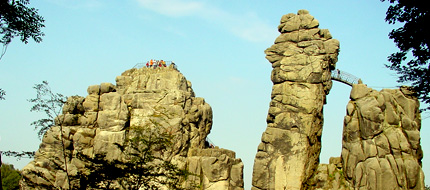
If the decision would be up to the National Association Lippe, the Externsteine Monument, located in the Nature Park Teutoburger Wald / Eggegebirge, would be declared as UNESCO World Heritage Site, soon. But, fortunately, this decision will not be made by the National Association or by any other German body or authority. It is up to the decision of UNESCO’s World Heritage Committee in Paris, whether a nominee will be awarded as a World Heritage Site or not.
Without doubt the Externsteine Monument is a significant landmark and a major tourist attraction within the nature park. The distinctive vertical rock cliffs of the Externsteine Monument are made of hard sandstone from the Cretaceous period, which were folded straight up some 70 million years ago. Over thousands of years, erosion has created the final appearance of the monument, which is attracting thousands of tourists year by year. Also the carved rock chapel, the three carved rooms and the large medieval cross relief sculpture underline the importance and mystique of the place.
It is true when the National Association Lippe promotes in a press release „The Externsteine with the unique cross relief and the surrounding nature reserve are an important natural and cultural monument of European importance“. But exactly this brings us back to the desired award as World Heritage Site. The UNESCO has strong criteria for a World Heritage Site. A World Heritage Site, as its name suggests, should have an outstanding universal significance for all mankind. It is doubtable if the Externsteine Monument fulfills these criteria, where even the National Association is talking about a European and not about a Global importance.
And right here a widespread problem of the World Heritage movement becomes obvious. Over the years – also and in particular in Germany – one can discover an inflationary use of the wish for a World Heritage award. Of course – the world’s most prestigious award for natural and cultural monuments assures masses of global world heritage tourists and finally notable financial income.
One can only guess that also in Lippe the wish for an increasing number of tourist is behind the scene of this most likely hopeless, though even marketing effective, initiative. Looking at the facts it becomes obvious that the Externsteine Monument will hardly become a World Heritage Site. First of all there is simply a lack of value of the monument, secondly, the tentative list, the list of nominees for potential new World Heritage Sites in Germany, is already well filled. And something else argues against the rock formation: The global strategy of the World Heritage Committee envisaged that in the first instance existing gaps in the global network of World Heritage Sites needs to be closed and such nominations should prevail which represents time periods and regions that have not yet sufficiently been listed in UNESCO’s World Heritage. Germany, with a total of 33 World Heritage Sites, and 4 of them in North Rhine-Westphalia, is already well represented. For example Egypt, famous in the world for pyramids, mummies and historic treasures, is hosting a total of 7 World Heritage Sites. Last but not least the World Heritage Committee might remember and consider the fact that Germany is one of the two countries which lost the World Heritage status for one of its designations, so far.
In summary one can estimate the initiative of the National Association Lippe as a successful marketing campaign. Media is talking about the Externsteine Monument! But that’s it. Now it is time to re-focus on more meaningful projects, before any funding for applications and nominations will be wasted.
Finally I would like to express two personal recommendations for a sustainable and successful tourist and regional development in Eastern Westphalia-Lippe (OWL):
In addition to World Heritage Sites and Biosphere Reserves a UNESCO Geopark is another very successful tool for conservation, promotion and tourism marketing of geological features. The European Network of Geoparks would certainly have an interest in a „significant natural and cultural monument of European importance“. A nomination may well be crowned with success and a UNESCO Geopark would also be a project with international efficacy.
But if Eastern Westphalia-Lippe is really seeking for its place on the international map of tourist destinations and if tourism wants to be developed successfully, and at the same time the natural and cultural heritage of the region should be conserved, the conclusion will lead to the fact that the National Park Teutoburger Wald needs to be declared. The well situated Nature Park, with a National Park in its heart, covering the area Senne, parts of the Teutoburger Forest and the Eggegebirge mountain range, would eventually afford the sorely needed tourism identity and would serve as the driving force for regional development in Eastern Westphalia-Lippe.
Unfortunately, the much discussed National Park is steadily blocked by unjustifiable self-interests and sensitivities and the realization of this promising activity is so far apart like the recognition of the Externsteine Monument as a World Heritage Site.
Further reading:
- DEUTSCHE UNESCO-KOMMISSION: Welterbe-Manual. Handbuch zur Umsetzung der Welterbekonvention in Deutschland, Luxemburg, Österreich und der Schweiz. 2009. 354p.
- HARTEISEN, U., P. LIEPMANN, H. BELZ, H. SCHWARZE & A. WIENDL: Förderung des Landtourismus NRW. Handlungsorientierte Konzeptstudie über die regionalökonomischen, u.a. touristischen Entwicklungsperspektiven einer Nationalparkregion Senne. 2003. 292p.
